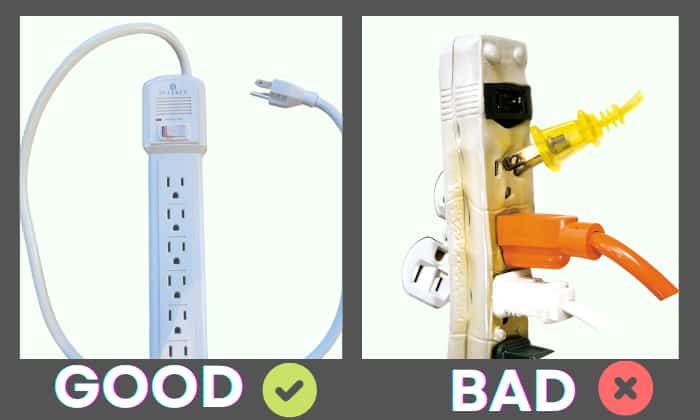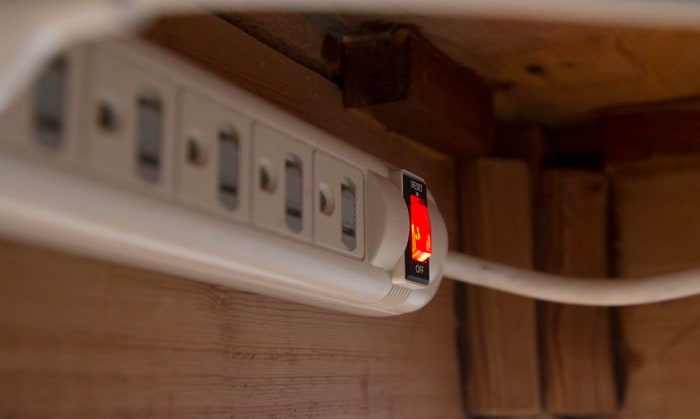More than we care to think about or admit, we’ve all had a device that seemed to last forever, despite long-time regular use. This is why asking, “Do surge protectors go bad?” is quite understandable.
Yes, a surge protector does age out. Have you had it for 5 years or more? The general, safe recommendation is to replace this type of device every 5 to 10 years.
Still, lifespan is not so much determined by how long you’ve had something as the damage it’s subjected to (i.e. how frequently it has protected your appliances).
Table of Contents
How Long Do Surge Protectors Really Last?
Let’s get this out of the way immediately: surge protectors don’t last forever. However, it’s hard to provide a definite answer to “How long does surge protector last?”
Why? Because I’ve seen surge protectors that still manage to remain functional for decades, even after they’ve suffered direct lightning hits over that period of time.
That’s precisely why I don’t readily subscribe to the recommendation of replacing surge protectors every 2 to 3 years. After all, we can’t deny that in some places, surges rarely occur – once every seven years, to be exact.
However, some people, especially RV enthusiasts, can attest to experiencing surges more frequently or around 4 to 5 times per year in various locations.
If you’re not already aware of it, a bad surge protector is one whose joule rating has fully diminished after protecting against power surges.
Read more: The safest whole house surge protector nowadays.
But What Do Surge Protectors Do Exactly?
To start off, they don’t work based on current like a breaker (excessively high amps will trip a breaker). A surge protector instead contains metal oxide varistors (MOV) that allow it to divert and, in turn, protect all devices connected to it against voltage surges.
For example, if it has a joule rating of 2,500, the integrated MOV can only absorb that amount of energy before failing.
Ultimately, varying surge frequencies and strengths make it hard to pinpoint an exact surge protector lifespan range.
Thus, I’ve come up with the following points when answering the main question:
- A surge protector’s lifespan will always mainly depend on how many surges it sees and how strong they are Surge protectors wear out differently, in short.
- Having a good ground path contributes to lengthening lifespan.
- Most surge protectors that need to be replaced every 2 to 3 years are likely not well-constructed or flat-out aren’t doing their job right. This is especially true if surge events seldomly happen and are relatively weak throughout the protector’s usage duration.
- Major surge events that happen regularly warrant more frequent surge protector replacement as opposed to small power issues occurring over the years.
How Do You Know if a Surge Protector Has Gone Bad?
“How to tell if a surge protector is bad?” is another area of confusion for a lot of people. Some Reddit users complain that they’re left completely in the dark by their surge protectors because of a lack of helpful indicators.
The good news is that in a few surge protectors, it shouldn’t be hard to diagnose one that’s failing.
- Most will have indicator lights that will start repeatedly blinking to notify you.
- Others will no longer give off a green light or light up the label indicating that protection is still present.
Overall, the two points above are the best ways to know whether you need to replace the surge protectors.
Is there a way for you to test whether a surge protector is still good to go? I’ve answered this question in the FAQ section below.
What Causes Surge Protectors to Go Bad?
Overloading or going over their rated capacity causes them to fail. For instance, strong surges often occur during lightning strikes. Certain power strips go bad immediately once these events happen if your surge protectors are not there to take the hit instead.
Additionally, you should not discount fluctuations that may occur during outages and the moment power is restored as well as the possibility of damaged wiring.
FAQs
How to test a surge protector?
Have you ever been in a situation where your surge protector stopped working and you wondered whether there was a way to test it?
Sadly, there’s no tool designed to test your average power strip or surge protector. It’s best to rely on the built-in indicator lights to know if it’s still functional.
If you’re thinking about surge protection devices (SPDs) that are more of a mainstay in power supply and telephone network protection systems, those are usually the ones that can be tested using a life tester, as demonstrated in this video:
What happens when a surge protector goes bad?
Depleted surge protectors will simply no longer be able to protect any device(s) that are plugged into them. They may still power appliances, but they’re now vulnerable to the surges’ damaging effects.
Conclusion
To provide a summarized answer to “Do surge protectors go bad?” yes, they do, but don’t expect them to last for the same length of time.
Some may encounter few or minimal surges that they’ll remain in working order for years and decades. Others may need to be replaced the moment they take enough beating from many powerful surges over time or a one-time thunderous event (pun very much intended).

I am Edwin Jones, in charge of designing content for Galvinpower. I aspire to use my experiences in marketing to create reliable and necessary information to help our readers. It has been fun to work with Andrew and apply his incredible knowledge to our content.


